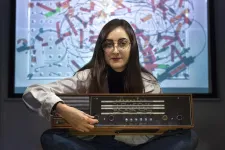(Press-News.org) In countries with a severe shortage of surgeons it is common for some operations to be carried out by medical staff with lower formal qualifications. Researchers at Karolinska Institutet, Sweden, have led an international study on the safety and efficacy of a common surgical procedure. The study, published in
JAMA Network Open, shows that inguinal hernia operations performed by associate clinicians at a hospital in Sierra Leone were just as safe and effective as those performed by doctors.
Many Sub-Saharan countries have a desperate shortage of surgeons, and to ensure that as many patients as possible can be treated, some operations are carried out by medical professionals who are not specialists in surgery. Such task sharing is supported by several bodies, including the World Health Organisation.
There are to date few clinical investigations into the safety and effectiveness of task sharing. Now researchers at Karolinska Institutet and, amongst other places, Kamakwie Wesleyan Hospital, Sierra Leone, have compared inguinal hernia operations performed by associate clinicians with those performed by non-specialist medical doctors. In Sierra Leone, medical doctors have no specific training in surgery but routinely perform surgical procedures as part of their regular work.
An estimated 220 million people around the world live with an inguinal hernia, which causes significant suffering and, 40,000 deaths each year. Twenty million inguinal hernia operations are performed every year, making it the most common general surgical procedure in the world, including in low-income countries like Sierra Leone. In Sierra Leone there are fewer than one surgeon per 100,000 population, and task sharing between MDs and associate clinicians is one way to provide general surgery to many people.
The study included 229 men operated on for inguinal hernia between 2017 and 2018 at a district hospital in rural Sierra Leone. The patients were randomly assigned to a doctor or an associate clinician for their surgery and were followed up after two weeks and one year.
The results suggest that task sharing with associate clinicians provides safe and effective surgery for non-life threatening inguinal hernias in countries where there is a shortage of surgeons.
"The study showed that associate clinicians were not inferior to registered doctors when it comes to recurrence, complications, groin pain or patient satisfaction," says the paper's last author Jenny Löfgren, assistant professor at the Department of Molecular Medicine and Surgery, Karolinska Institutet. "There were even fewer cases of recurrence in the patients who had been operated on by associate clinicians compared to the group operated on by MDs. This was an extremely unexpected finding and task sharing appears to be an attractive option that can help the millions of people suffering from inguinal hernia."
The researchers' next step is to develop training programmes for doctors and associate clinicians in order to expand surgical services. Forthcoming studies will be conducted in Sierra Leone and Uganda.
INFORMATION:
The study was financed by the Swedish Research Council. Authors Håkon Bolkan, Alex van Duinen and Thomas Ashley are unpaid members of the CapaCare board. There are no other reported conflicts of interest.
Publication: "Outcomes after elective inguinal hernia repair performed by associate clinicians versus medical doctors - a randomized, single blinded non-inferiority trial." Thomas Ashley, Hannah Ashley, Andreas Wladis, Håkon A. Bolkan, Alex J. van Duinen, Jessica H. Beard, Hertta Kalsi, Juuli Palmu, Pär Nordin, Kristina Holm, Michael Ohene-Yeboah, Jenny Löfgren. JAMA Network Open, online 11 January, 2020.
Would you like to capture a chemical transformation inside a cell live? Or maybe revolutionize microchips' production by printing paths in a layer that has a thickness of just 100 nanometers? These and many other goals can now be achieved with the latest femtosecond laser created by a team of scientists led by Dr. Yuriy Stepanenko.
These days, there is a multitude of laser light sources. They each have their characteristics and different applications, such as observing stars, treating illnesses, and surface micro-machining. "Our goal is to develop new ones," says Yuriy Stepanenko, head of the team of Ultrafast Laser Techniques at the Institute of Physical Chemistry of the Polish Academy of Sciences. "We deal with sources that produce ultrashort pulses of light. Really very, ...
The study found a "systematic and quantifiable pattern" of political parties officers opting against fielding minority candidates where they perceive that their non-white appearance might prevent a win. This includes constituencies already held by the party, and those within reach, requiring just a small swing in the vote to change hands.
Dr Patrick English, from the University of Exeter, who carried out the research, said: "This combination of public opinion and party strategy is one of the most significant blockages to electing parliaments which fully reflect ...
A team of researchers from Colorado State University and the University of Cincinnati have discovered a new mode of snake locomotion that allows the brown tree snake to ascend much larger smooth cylinders than any previously known behavior.
This lasso locomotion, named because of a lasso-like body posture, may contribute to the success and impact of this highly invasive species. It allows these animals to access potential prey that might otherwise be unobtainable and may also explain how this species could climb power poles, leading to electrical outages.
Researchers said they hope the findings will help people protect endangered birds from the snakes.
The ...
Researchers reporting in Current Biology on January 11 have discovered that invasive brown tree snakes living on Guam can get around in a way that had never been seen before. The discovery of the snake's lasso-like locomotion for climbing their way up smooth vertical cylinders has important implications, both for understanding the snakes and for conservation practices aimed at protecting birds from them.
"Our most important finding is a new mode of snake locomotion," says co-senior author Julie Savidge of Colorado State University (CSU). "Only four major types have been recognized for nearly 100 ...
What The Study Did: Researchers examined pediatric COVID-19 hospitalization trends in 22 states for both severity among this population and spread of the virus.
Authors: Pinar Karaca-Mandic, Ph.D., of the University of Minnesota Carlson School of Management in Minneapolis, is the corresponding author.
To access the embargoed study: Visit our For The Media website at this link https://media.jamanetwork.com/
(doi:10.1001/jamapediatrics.2020.5535)
Editor's Note: The article includes conflict of interest and funding/support disclosures. Please see the article for additional information, including ...
What The Study Did: Medical records for patients admitted to an urban academic medical center were analyzed for race and ethnicity for evidence of racial bias in clinician documentation.
Authors: Jessica R. Balderston, M.D., of Virginia Commonwealth University Medical Center in Richmond, is the corresponding author.
To access the embargoed study: Visit our For The Media website at this link https://media.jamanetwork.com/
(doi:10.1001/jamainternmed.2020.5792)
Editor's Note: The article includes conflicts of interest disclosures. Please see the article for additional information, including other authors, author contributions and affiliations, conflict of interest ...
BOSTON - A diet rich in healthy and plant-based foods is linked with the presence and abundance of certain gut microbes that are also associated with a lower risk of developing conditions such as obesity, type 2 diabetes and cardiovascular disease, according to recent results from a large-scale international study that was co-senior authored by Andrew T. Chan, MD, MPH, from Massachusetts General Hospital (MGH). The report appears in Nature Medicine.
"This study demonstrates a clear association between specific microbial species in the gut, certain foods, and risk of some common ...
Smartwatches and other battery-powered electronics would be even smarter if they could run AI algorithms. But efforts to build AI-capable chips for mobile devices have so far hit a wall - the so-called "memory wall" that separates data processing and memory chips that must work together to meet the massive and continually growing computational demands imposed by AI.
"Transactions between processors and memory can consume 95 percent of the energy needed to do machine learning and AI, and that severely limits battery life," said computer scientist Subhasish Mitra, senior author of a new study published in Nature Electronics.
Now, a team that includes Stanford computer scientist ...
Fish populations tend to do better in places where rigorous fisheries management practices are used, and the more measures employed, the better for fish populations and food production, according to a new paper published Jan. 11 in Nature Sustainability.
The study, led by Michael Melnychuk of the University of Washington's School of Aquatic and Fishery Sciences, draws upon the expertise of more than two dozen researchers from 17 regions around the world. The research team analyzed the management practices of nearly 300 fish populations to tease out patterns that lead to healthier fisheries across different locations. Their findings confirmed, through extensive data analysis, what many researchers ...
Galaxies begin to "die" when they stop forming stars, but until now astronomers had never clearly glimpsed the start of this process in a far-away galaxy. Using the Atacama Large Millimeter/submillimeter Array (ALMA), in which the European Southern Observatory (ESO) is a partner, astronomers have seen a galaxy ejecting nearly half of its star-forming gas. This ejection is happening at a startling rate, equivalent to 10 000 Suns-worth of gas a year -- the galaxy is rapidly losing its fuel to make new stars. The team believes that this spectacular event was triggered by a collision with another ...




